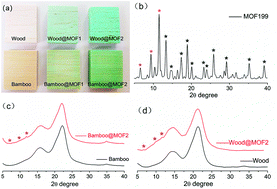In situ deposition of MOF199 onto hierarchical structures of bamboo and wood and their antibacterial properties†
Abstract
Tremendous efforts have been dedicated to developing functionalized cellulose materials by synthesis with copper-based metal–organic frameworks (MOF199), also known as HKUST-1. However, few studies have explored the deposition of MOFs on woody materials due to the complex chemical compositions of these materials (cellulose, hemicellulose, lignin) and their difficulty of bonding with MOF crystals. In this article, for the first time, MOF199 was successfully synthesized onto two different woody materials, moso bamboo and balsa wood, via in situ deposition at room temperature. The results show that the diverse surface roughness and the hierarchical structures of woody materials have significant effects on the size of MOF199 crystal. Additionally, bamboo and wood coated with MOF199 exhibited better antibacterial activities against Staphylococcus aureus (S. aureus) than Escherichia coli (E. coli); they could minimize S. aureus colony levels to 2.08 from 8.98 CFU cm−2. This study provides a facile method for the functionalization of woody materials with MOFs for antibacterial applications.



 Please wait while we load your content...
Please wait while we load your content...